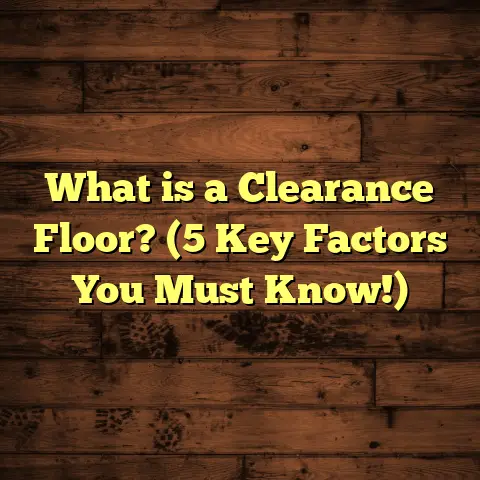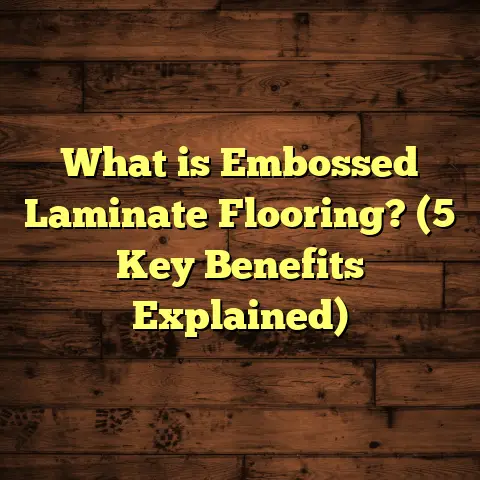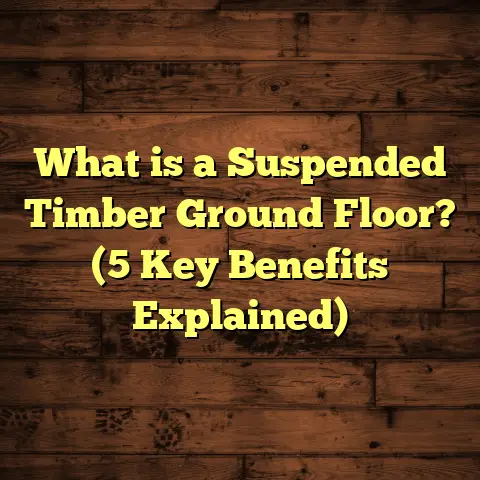What is White Powder on My Concrete Floor? (5 Causes Explained)
Technology keeps changing how we deal with home repairs and maintenance. For example, concrete floors—once just a simple slab—now come with many questions. One common one I get asked is, “What’s that white powder on my concrete floor?” It might seem like a small thing, but it can say a lot about your floor’s health. I’ve handled hundreds of floors over the years, and I want to share what I’ve learned about this mysterious white powder.
What Is White Powder on My Concrete Floor?
White powder on concrete is usually a substance called efflorescence. It looks like a fine, chalky dust or crystals sitting on the surface. This happens when moisture inside the concrete brings salts to the surface and then evaporates, leaving behind the salt residue.
You might see it in your basement, garage, patio, or any concrete spot exposed to moisture. Sometimes it shows up after rain, sometimes after cleaning your floor. It can seem harmless, but it tells us about moisture movement and potential issues with your concrete.
Now, efflorescence isn’t the only cause of white powder. There are several reasons, and each needs a different approach. So let’s break down the 5 main causes I’ve come across in my work and explain how you can spot and handle them.
1. Efflorescence: The Most Common Culprit
Efflorescence happens when water moves through concrete, picking up soluble salts inside. When the water reaches the surface and evaporates, it leaves the salts behind as a white powder.
How Does This Work?
Concrete is porous, meaning it has tiny holes that allow water to pass through. Inside the concrete mix, materials like cement contain salts such as calcium, sodium, or potassium compounds. When water moves through the concrete, it dissolves these salts.
Once the water reaches the surface and evaporates, the salts crystallize into that white powder you see. The process is ongoing as long as moisture keeps moving through the concrete.
What I’ve Seen in Real Life
In one of my projects renovating an old warehouse floor, efflorescence showed up heavily near the entrance where rainwater seeped under the door. The white powder was thick enough to make the floor slippery. We had to seal the cracks and install better drainage to stop water intrusion.
Some Numbers
Studies show that efflorescence can affect up to 40% of concrete floors exposed to ground moisture or rain without proper sealing. In new construction, it’s often linked to curing practices or poor drainage.
The Chemistry Behind It
To give you some technical insight: Portland cement—the most common cement type—contains calcium hydroxide (Ca(OH)₂) and other compounds. When water penetrates the concrete, these compounds dissolve into calcium ions (Ca²⁺) and hydroxide ions (OH⁻). These ions migrate to the surface with water. Once at the surface, they react with carbon dioxide (CO₂) in the air forming calcium carbonate (CaCO₃), which is insoluble and appears as white deposits—this is efflorescence.
Why Does Efflorescence Matter?
While efflorescence itself isn’t structurally harmful—it’s more cosmetic—it signals moisture movement through your slab. Persistent moisture could lead to more serious problems like corrosion of steel reinforcement bars (rebar), freeze-thaw damage in cold climates, or mold growth nearby.
How to Prevent Efflorescence
- Control Moisture Sources: Make sure gutters and downspouts direct water away from your foundation.
- Use Vapor Barriers: Installing vapor barriers beneath slabs limits moisture rise.
- Seal Concrete Floors: Use good quality penetrating sealers that allow vapor transmission but block liquid water.
- Improve Drainage: Around exterior walls to keep water away.
- Proper Curing: In new concrete pours, ensure proper curing times to reduce excess water.
Removing Efflorescence
If you already have it:
- Use a dry brush or broom regularly.
- Wash with mild vinegar solution (1 part vinegar to 5 parts water).
- Rinse well with clean water.
- Avoid strong acids unless applied by professionals because they can damage concrete.
2. Concrete Dust: Surface Degradation or Grinding Residue
Sometimes white powder isn’t salt but actual concrete dust caused by surface wear or grinding.
What Causes Concrete Dust?
If your concrete floor has been recently ground or polished, fine dust particles may remain on the surface. Also, heavy foot traffic or abrasive cleaning can wear down the surface layer, creating dust.
Concrete is made of cement paste binding aggregates like sand and gravel. When surface layers break down due to mechanical wear or chemical attack (like acid rain), the fine particles come loose resulting in dusting.
My Experience With Concrete Dust
I remember working on a commercial garage renovation where previous owners used harsh chemical cleaners combined with pressure washing. Over time the top layer of concrete wore thin and started turning powdery in high-traffic zones.
Another time, polishing a residential basement floor revealed dust because the contractor did not properly vacuum during grinding stages. Leaving dust on polished surfaces reduces shine and causes safety hazards.
How Dusting Affects Floors
Concrete dust can:
- Make floors slippery.
- Cause respiratory irritation if inhaled.
- Indicate poor surface integrity.
- Signal inadequate sealing or maintenance.
Statistics About Dusting
Industry data suggests around 10-15% of concrete floors experience dusting within 5 years if not sealed or maintained properly.
Preventing and Repairing Dusting Floors
- Sealing: Properly seal floors with penetrating or topical sealers.
- Maintenance: Regular cleaning without harsh chemicals.
- Repairs: Use densifiers or hardeners that chemically react with cement to strengthen surfaces.
- Polishing Best Practices: Vacuum thoroughly during grinding to remove dust before sealing.
3. Residue from Cleaning Agents or Sealers
White powder can also come from leftover residues of cleaning products or sealers that have dried on your floor.
Why Does This Happen?
Some cleaners contain compounds that leave a white film if not rinsed off properly. Similarly, sealers or coatings that are improperly applied or old may degrade into powdery residue.
This is especially common when:
- Using alkaline cleaners on acidic surfaces.
- Over-applying sealers.
- Applying incompatible products on top of each other.
- Not rinsing products fully after cleaning.
Story From My Fieldwork
One homeowner called me frustrated that her basement floor kept developing a white haze despite regular cleaning. Upon inspection, I found multiple layers of different sealers applied over years with no stripping in between. The incompatible layers broke down chemically and left powdery residues behind.
We had to strip all old coatings carefully using chemical strippers and then reapply suitable sealers compatible with her floor type.
Data From Flooring Professionals
A flooring industry survey reported that nearly 30% of complaints about white residue on floors were traced back to cleaning mistakes or sealer misuse.
How To Avoid Residue Problems
- Always read product labels before use.
- Use cleaners formulated specifically for concrete floors.
- Test clean small areas before full application.
- Follow manufacturer instructions for drying times.
- Avoid mixing different sealer types unless compatible.
- Periodically strip old coatings if buildup occurs.
4. Lime Leaching: When Cement Reacts With Water
Lime leaching is a chemical reaction where calcium hydroxide (lime) inside cement reacts with water and forms white deposits on the surface.
The Science Behind Lime Leaching
Cement contains free lime (calcium hydroxide), which is slightly soluble in water. When groundwater or rainwater permeates concrete continuously, lime dissolves and migrates toward the surface. On reaching the surface and contacting air CO₂, it forms calcium carbonate crystals visible as white powder or crusts.
Signs You Have Lime Leaching
- White chalky deposits that feel rough or flaky.
- Deposits may be thicker than efflorescence.
- Often found in areas exposed to constant moisture like patios or walls near soil.
- Deposits may be harder to remove than efflorescence because calcium carbonate can harden over time.
Case Study From My Work
I worked on an outdoor concrete patio where persistent white crusts appeared every spring after winter thaw. Tests showed lime leaching due to poor waterproofing combined with freeze-thaw cycles forcing moisture deep inside concrete.
We applied waterproof coatings designed for masonry plus improved drainage around planting beds near the patio edges. The deposits reduced significantly over subsequent seasons.
How Common is Lime Leaching?
Research indicates lime leaching affects roughly 25% of unsealed exterior concrete exposed to regular wet-dry cycles annually.
Managing Lime Leaching
- Keep surfaces dry via waterproofing sealers.
- Improve site drainage.
- Repair cracks where water can enter.
- Use lime-resistant cement mixes in new pours if possible.
5. Mold or Mildew: A Different Kind of White Powder
Sometimes what looks like white powder isn’t mineral at all but biological growth like mold or mildew.
How To Tell If It’s Mold
Mold often appears patchy rather than uniform powdery coating. It may have fuzzy texture or spots rather than crystalline form like salts. Mold growth usually comes with a musty smell which salts do not produce.
Basements, garages, or patios with poor ventilation and persistent moisture are common sites for mold growth on concrete surfaces.
My Experience Identifying Mold vs Efflorescence
One client complained about “white powder” in a damp basement that kept coming back no matter how often she cleaned it. Testing showed fungal spores growing on damp patches rather than salt deposits.
Treating this required removing mold using fungicides plus fixing humidity via ventilation improvements—not just scrubbing powder away like efflorescence.
Health Risks From Mold on Floors
Mold spores can cause allergic reactions, respiratory issues, and worsen asthma symptoms—especially indoors where people spend a lot of time near floors.
According to CDC data:
- About 10–50% of indoor environments have some mold contamination.
- Damp surfaces are major contributors.
What To Do If You Suspect Mold
- Get professional mold testing kits.
- Clean affected areas with mold-specific cleaners.
- Fix moisture sources immediately (leaks, humidity).
- Improve airflow and ventilation.
- Consider professional remediation for extensive mold.
More Causes Worth Mentioning
While these five are main causes I encounter regularly, there are some other less common reasons for white powder on concrete floors:
A. Salt Contamination From External Sources
If your floor is near salty environments (like coastal areas) or exposed to deicing salts during winter, salt crystals can accumulate on surfaces appearing as white powder.
B. Chemical Reactions From Industrial Products
In industrial settings using harsh chemicals or alkalis on floors, chemical reactions can produce white residues over time.
C. Drying Cement Dust After Repairs
If recent patching or resurfacing work occurred without proper cleanup, fresh cement dust can leave white residues until fully washed away.
How To Diagnose What’s Causing Your White Powder?
Diagnosing correctly saves time and money because treating efflorescence vs mold or dust requires different approaches.
Here’s a simple checklist I use:
| Step | Action | What You Learn |
|---|---|---|
| Visual Inspection | Look closely at texture & location | Powdery salt vs fuzzy mold |
| Moisture Check | Use moisture meter on floor | Confirms presence of moisture |
| Smell Test | Smell area for musty odors | Indicates possible mold |
| Water Test | Wet a small area & see if powder dissolves | Salts dissolve; dust/mold don’t |
| pH Test | Use pH strips on powder | Acidity/basicity clues for residue |
| Professional Testing | Send samples for lab analysis | Definitive identification |
Personal Tips From Years Working With Concrete Floors
- Don’t Ignore Signs: White powder means moisture issues somewhere—address early.
- Avoid Harsh Chemicals: They can worsen problems by damaging concrete surfaces.
- Routine Maintenance: Regular cleaning with proper products keeps floors healthy.
- Seal Regularly: Good sealers prevent moisture intrusion and dusting.
- Improve Drainage & Ventilation: These two factors control moisture—the root cause behind most white powders.
- Hire Experts When Needed: Complex problems like mold contamination require professional help for safety reasons.
Frequently Asked Questions About White Powder on Concrete Floors
Q: Is white powder dangerous?
A: Usually no—efflorescence and lime deposits aren’t toxic but indicate moisture issues which can cause damage if ignored. Mold powders could pose health risks.
Q: Can I remove it myself?
A: Efflorescence often can be removed by gentle scrubbing and vinegar solutions at home. Mold requires specific cleaning agents; extensive cases call for professionals.
Q: Will sealing stop white powder?
A: Sealing helps prevent moisture migration causing salts to form but doesn’t remove existing deposits instantly.
Q: Does humidity cause this?
A: Yes! High humidity promotes moisture absorption in concrete which leads to these powders forming over time.
Final Thoughts About Your Concrete Floor’s White Powder
That white stuff on your floor isn’t just dirt—it tells a story about your home’s environment and floor condition. Whether it’s harmless efflorescence or something more serious like mold growth, understanding what causes it helps you take smarter actions.
I’ve seen how small problems ignored grow into expensive repairs—so always keep an eye out for those white powders and act early!
If you want tailored advice on your specific floor—what products to use or how to fix recurring issues—reach out anytime. Helping floors look great and last long has been my passion for years!





